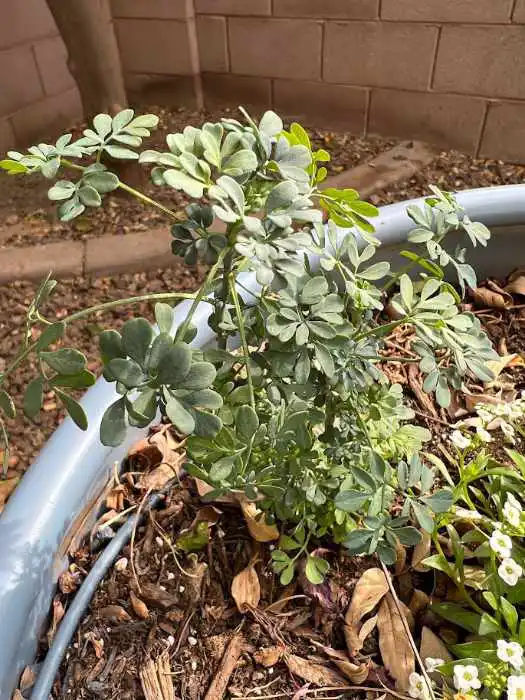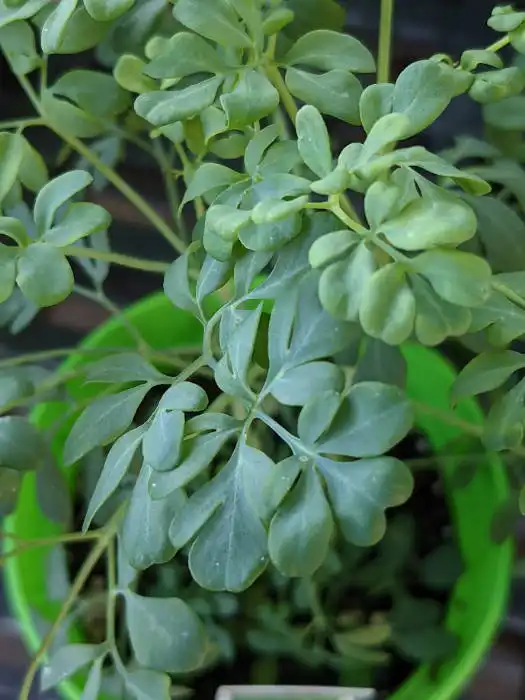Rue is a bitter herb traditionally used medicinally. Are you looking to plant a unique herb? Often found in old-world gardens, rue adds both beauty and function to your garden space.
This post may contain affiliate links. Please see my disclosure policies. If you purchase after clicking an affiliate link we may receive small commission at no cost to you. As an Amazon Associate I earn from qualifying purchases.
An Old World Herb – Rue
Rue is not a typical herb, but this old world herb attracts pollinators and is a host plant for a few butterflies. It tends to spread out as it grows, forming a bushy, rounded shape.
You might notice its blue-green, feathery leaves and small yellow flowers, which usually bloom in late spring or early summer. The flowers aren’t just pretty; they also attract beneficial insects and pollinators to your garden.
When to Plant Rue
You can start planting rue either from seeds or from cuttings. If you’re using seeds, the best time to plant them is in early spring, right after the last frost.
Rue seeds thrive in warm soil, so waiting until the soil has warmed up is key. If you prefer using cuttings or small plants, you can plant rue at the same time or even a bit later, up until early summer.
When to Plant Rue in Phoenix
In warmer climates, like Phoenix you can also plant rue in the spring and fall. Just make sure the temperatures aren’t too extreme, as young rue plants do best in moderate conditions.
Types of Rue
Ruta graveolons
The most common type you’ll find is the traditional Ruta graveolens. This is the type of rue that most people grow for its culinary and medicinal uses.
Ruta chalepensis
Also known as fringed rue, this variety has more delicate, finely divided leaves and is slightly less hardy than Ruta graveolens.
Ruta montana
This variety is similar to Ruta graveolens but tends to grow a bit larger and is often found in mountainous regions.
How to Plant Rue
Planting rue is straightforward and perfect for beginners. Under ideal conditions, you can expect to see rue seedlings sprouting within two to three weeks after planting.
After planting, water the seeds or cuttings gently. Rue doesn’t like soggy soil, so make sure the water drains well and doesn’t pool around the plants.
Rue prefers full sun but can tolerate partial shade. Pick a spot in your garden that gets at least six hours of sunlight a day.
Rue isn’t too picky about soil, but it thrives in well-drained soil with a slightly alkaline pH. If your soil is heavy or clay-like, consider mixing in some sand or compost to improve drainage.
If you’re planting seeds, sow them directly into the soil about a quarter-inch deep. Space the seeds or cuttings about 12-18 inches apart to give the plants room to grow.
What is Rue Used For?
Rue is not as well-known as parsley, but it is an incredibly versatile herb, used throughout history for various purposes. Here’s a quick rundown of its many uses:
Traditionally, rue was used as a remedy for a variety of ailments, from digestive issues to insect bites.
Today, it’s still used in some herbal medicine practices, though it’s important to note that rue can be toxic in large quantities, so it should be used with caution.
This bitter herb is used in Mediterranean cuisine, especially in Italy and Greece, for sauces and salads.
Rue’s attractive foliage and flowers make it a great addition to ornamental gardens. It pairs well with other herbs and flowering plants, creating a beautiful, textured landscape.
Rue is known to repel insects, particularly flies and mosquitoes. Planting rue near outdoor seating areas or entrances to your home can help keep these pesky bugs at bay.
Companion Plants for Rue
Rue works well with several other plants in the garden, making it an excellent companion plant. Here are a few plants that benefit from being planted near rue:
- Rue is often planted near roses to help repel pests that commonly affect rose bushes.
- Like rue, Sage has strong aromatic qualities that deter pests, making them great partners in the garden.
- Rue and lavender both prefer similar growing conditions, and their combined scents create a powerful insect-repellent barrier.
- Rue can help protect cabbage and other brassicas from pests like cabbage moths.
On the flip side, avoid planting rue near basil, as the two don’t get along well in the garden.
Carrots Love Tomatoes: Secrets of Companion Planting for Successful Gardens. Louise Riotte’s book is one of my favorite gardening books. It is packed full of helpful information if you’re interested in companion gardening.
How to Care for Rue
Light Requirements: Rue thrives in full sun, so choose a spot in your garden that gets at least six hours of sun. In Provide afternoon shade in warmer climates like Arizona.
Watering: When it comes to watering rue, less is more. Rue is drought-tolerant once established, so it’s better to let the soil dry out between waterings. Water deeply when you do water, but make sure the soil drains well.
Rue isn’t fussy about soil as long as it drains well. It can tolerate poor soils.
Pruning: If your rue plants are getting too large, you can also cut them back by about a third in the fall.
Harvesting Rue
Rue plants will reach their full height—typically between 18-24 inches—by the end of the growing season.
You can start harvesting rue leaves once the plants are well-established, usually after the first year of growth.
Use sharp scissors or pruning shears to cut the leaves and stems. Rue leaves can be used fresh or dried for later use. If you’re drying rue, spread the leaves out in a single layer on a drying rack or hang small bundles upside down in a well-ventilated area.



